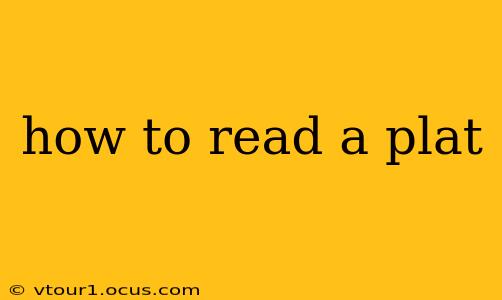Understanding plats is crucial for anyone involved in real estate, land surveying, or property management. A plat, essentially a map, provides a detailed legal description of a parcel of land, showing its boundaries, dimensions, and often, improvements like buildings and easements. This guide will walk you through the essential elements of reading a plat, enabling you to decipher this important legal document.
What is a Plat?
A plat is a detailed, scaled drawing showing the location and boundaries of a piece of land. It's a legal document, officially recorded with the relevant county or municipality, and serves as the primary reference for property location and boundaries. Think of it as a detailed blueprint for a piece of land, often used for subdivisions, but also individual lots. It's more than just a simple map; it's a legal record defining property ownership.
Key Elements Found on a Plat:
Plats contain several crucial pieces of information. Understanding these elements is key to interpreting the document correctly.
1. Property Lines and Boundaries:
These are depicted as solid lines, indicating the exact perimeter of the property. Precise measurements, usually in feet, are provided along these lines. Pay close attention to the angles and distances to understand the property's shape and size accurately.
2. Bearings and Distances:
Bearings represent the direction of a property line relative to north. They're typically expressed in degrees, minutes, and seconds (e.g., N45°30'15"W). Distances are the lengths of the property lines, usually measured in feet. These bearings and distances are vital for precisely determining the property's boundaries.
3. Lot and Block Numbers:
Each individual parcel of land within a subdivision is assigned a unique lot number. The plat will clearly identify the lot number(s) for each property shown. This, combined with the block number (if applicable), creates a unique identifier for the specific lot.
4. Monumentation:
Plats often indicate the location of physical markers, known as monuments, used to establish property corners. These could be iron pipes, concrete monuments, or other durable markers. Understanding monument locations is crucial for on-the-ground identification of property boundaries.
5. Easements:
Easements, which grant rights to use a portion of the property to another party (like utility companies for access to lines), are often shown on plats. These are typically marked with specific notations and may delineate areas where certain activities are permitted.
6. Right-of-Ways:
Similar to easements, right-of-ways grant access across a property. These are often depicted for roads, streets, or utility corridors. They show areas where the property owner might have limited control.
7. Improvements:
Plats sometimes include representations of existing structures, such as buildings, fences, or other permanent improvements. While not always to scale, they help visualize the property's usage and development.
8. Legal Description:
A plat will often include a legal description of the property. This description, usually a metes and bounds description, provides a precise textual definition of the property's boundaries, confirming the graphical representation on the plat.
How to Read a Plat: A Step-by-Step Approach
-
Start with the Legend: Look for a legend or key that explains the symbols used on the plat.
-
Identify the Property: Locate the specific lot and block number you're interested in.
-
Trace the Boundaries: Follow the property lines to understand the shape and size of the parcel.
-
Check Bearings and Distances: Note the bearings and distances of each property line for a precise understanding of the property's boundaries.
-
Examine Improvements and Easements: Pay attention to any structures, easements, or right-of-ways indicated on the plat.
-
Review the Legal Description: Compare the graphical representation with the textual legal description to ensure consistency.
-
Consult a Professional if Needed: If you have any doubts or difficulties interpreting the plat, consult a licensed surveyor or real estate professional.
Frequently Asked Questions (FAQs)
What is the difference between a plat and a survey?
While both provide information about property boundaries, a plat is a general representation often used for subdivision development, whereas a survey is a more precise, on-the-ground measurement of property boundaries, often used for legal and construction purposes.
Where can I find a plat?
Plats are typically recorded with the county recorder's office or equivalent local government agency. You can often access them online through the county's website or by visiting the office in person.
Can I interpret a plat myself, or should I consult a professional?
While you can try to interpret a plat yourself, especially with a guide like this, consulting a surveyor or real estate professional is recommended, particularly for complex plats or when making significant decisions based on its contents. They have the expertise to interpret the data accurately and avoid misinterpretations which may result in costly errors.
Understanding plats is a skill that enhances knowledge of land ownership and property rights. By understanding the key elements and following a structured approach, you can effectively read and interpret these crucial legal documents. Remember, when in doubt, seek professional guidance.
